Key takeaways:
- Canvassing is about building personal connections with voters, allowing for genuine conversations that can motivate political engagement.
- Engaging voters fosters a sense of community and inclusion, transforming voting into a personal commitment.
- Listening actively and adapting messages to individual experiences enhances the effectiveness of canvassing efforts.
- Patience and vulnerability in conversations can lead to deeper connections and open-mindedness among voters.
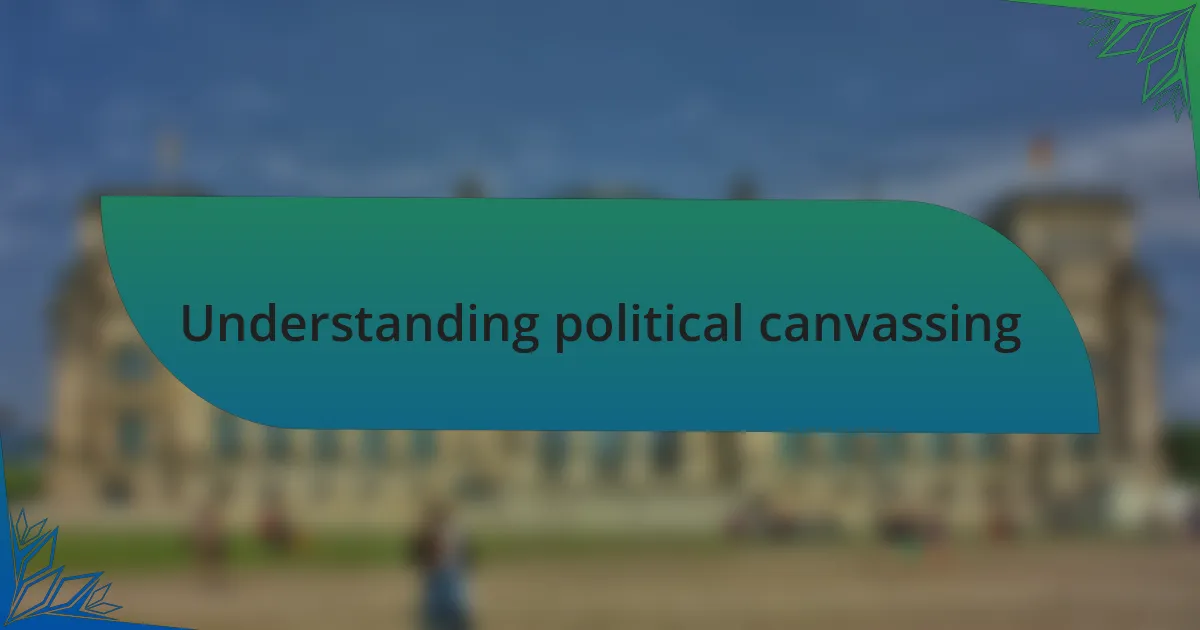
Understanding political canvassing
Canvassing is an essential part of the political process, involving volunteers going door-to-door to engage voters directly. I still remember the moment I knocked on my first door during a campaign. Nervously, I wondered, would they open up and talk to me, or would I just be met with indifference or even hostility? That initial fear quickly turned into excitement as I realized the potential for genuine conversations and connections.
As I walked through neighborhoods, I learned that canvassing isn’t just about delivering a message; it’s about listening to the concerns and hopes of the community. One particular encounter stands out: an elderly woman shared her worries about healthcare access while I stood there with my clipboard, feeling the weight of her words. This experience reminded me of the human side of politics—we’re not just voters or candidates; we’re neighbors, each with our own stories.
The emotional and personal connections forged during these interactions can sway opinions and motivate people to vote. Have you ever struck up a conversation about something you’re passionate about and found common ground? That’s the essence of canvassing. It’s about finding that shared interest or concern that can turn a casual chat into a motivating call to action. These moments are what make canvassing a powerful tool in shaping our political landscape.

Importance of voter engagement
Engaging voters goes beyond just encouraging them to show up at the polls; it recognizes their voices and validates their concerns. During my canvassing experiences, I often encountered individuals who felt their vote didn’t matter, a sentiment that deeply saddened me. Have you ever felt that way? It’s crucial to remind ourselves that every vote carries weight and can contribute to real change in our communities.
I recall one afternoon when I met a young father who expressed frustration with the local education system. Through our conversation, I could see the passion in his eyes—a desire for his children to have better opportunities. It struck me how powerful these dialogues are; they transform the abstract idea of voting into a personal commitment. Voter engagement opens the door to understanding the priorities of different demographics, which can profoundly influence campaign strategies.
Moreover, the process of engaging with voters fosters a sense of community and inclusion. I’ve seen neighbors rally together during canvassing events, sharing not just their thoughts on politics but also their dreams for the future. This collective spirit can ignite a sense of responsibility—when we feel that our opinions matter, we’re more likely to take action, whether it’s casting our votes or advocating for change. Isn’t it amazing how a simple conversation can activate a community?
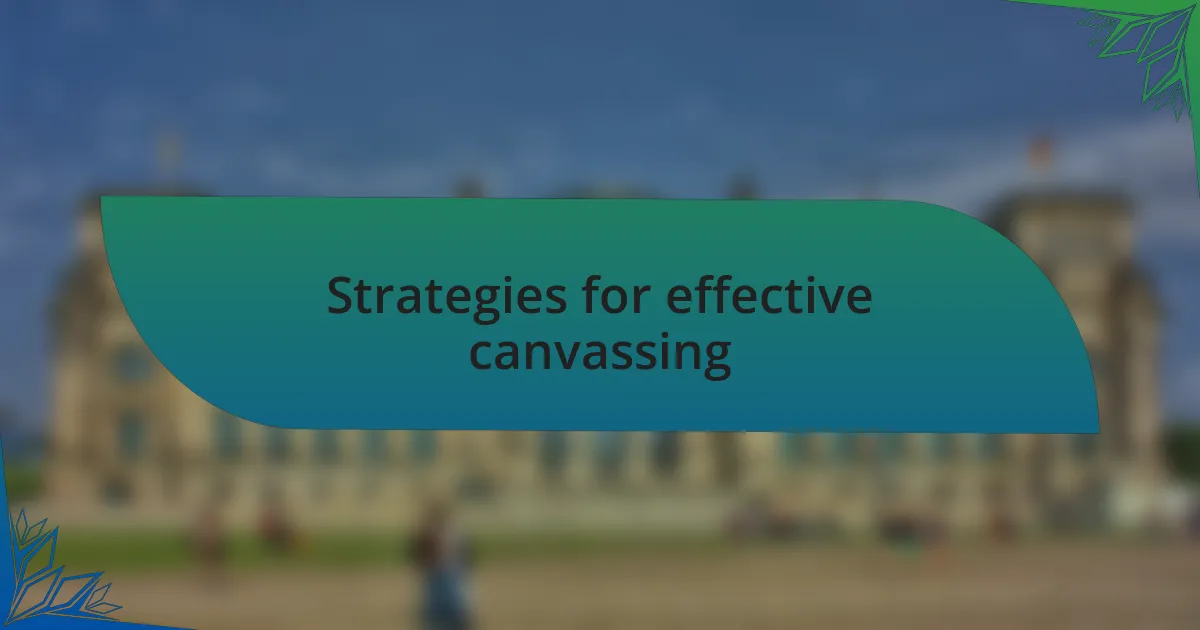
Strategies for effective canvassing
When it comes to canvassing effectively, understanding your audience is paramount. I remember approaching a neighborhood where residents felt disconnected from local politics. Instead of launching into my campaign spiel, I asked questions about their concerns. This shift to a more conversational approach allowed me to listen actively, and it made a significant difference in how receptive they were to discussing the issues—people truly appreciate when their feelings are validated.
Another strategy I believe is critical is tailoring your message to resonate with individual experiences. During one canvassing day, I spoke with a retired nurse who was passionate about healthcare access. I shared a personal story about a family member’s struggle with medical costs, which sparked an engaging discussion about health policy. It was a moment of connection that reinforced my belief that personal stories can bridge gaps and create shared understanding.
Finally, it’s vital to follow up and keep the conversation going beyond that initial interaction. After one session, I collected emails from voters who expressed interest in learning more about the campaign. When I later sent them updates and information about upcoming events, the responses were overwhelmingly positive. Doesn’t it feel rewarding to nurture those connections? Following through not only maintains interest but also builds trust and informs the community that their voices continue to matter long after the canvassing ends.
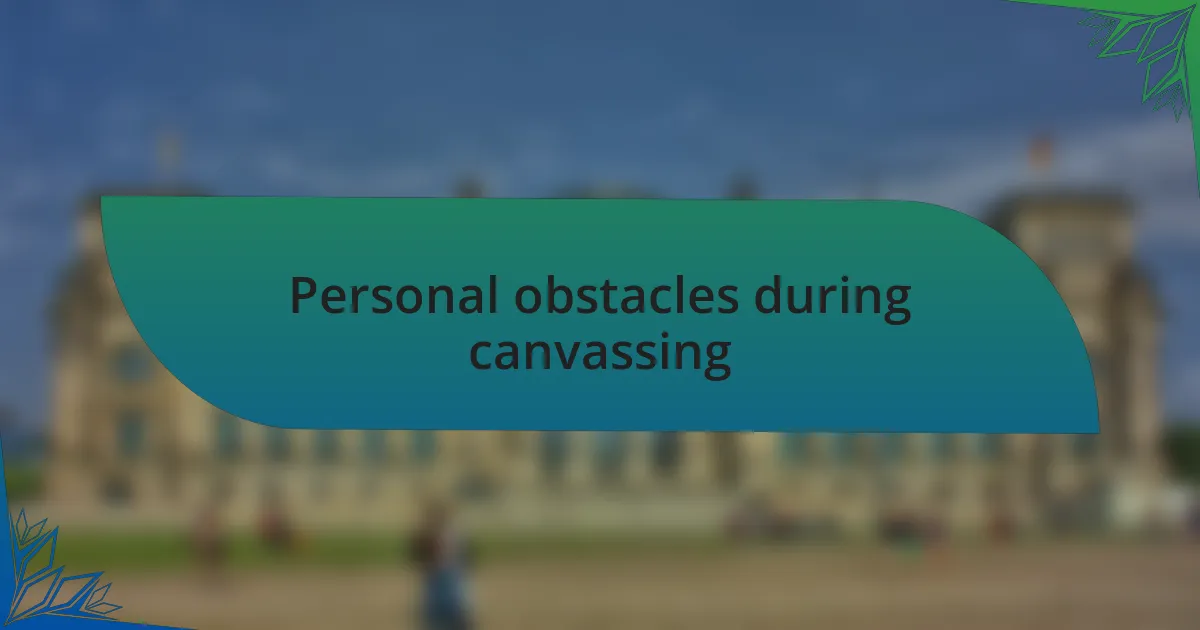
Personal obstacles during canvassing
One personal obstacle I faced while canvassing was the sheer physical fatigue that often set in after hours of knocking on doors. There were days when the sun scorched down or rain drenched my clothes, leaving me mentally and physically drained. I found myself asking, “Is it worth this exhaustion?” But then, a warm smile from a supporter or an encouraging wave from a passerby reminded me of the purpose behind my efforts, reigniting my motivation.
Another challenge was navigating the emotional toll of encountering indifference or hostility. I vividly remember one interaction where a resident sharply dismissed my approach, leaving me momentarily speechless. It’s moments like these that make you wonder, “Why does outreach sometimes feel like an uphill battle?” Yet, I had to remind myself that not everyone aligns with our views, and resilience is key. Each rejection served as a reminder that change often starts with uncomfortable conversations.
Finally, I grappled with the mental hurdle of overcoming self-doubt. Was I presenting the campaign message clearly enough? With unexpected questions thrown my way, I sometimes felt caught off guard. Reflecting on these experiences, I realized that none of us are experts right away. What kept me going was the understanding that growth often comes from stepping outside our comfort zones and embracing challenges along the way. Isn’t that where true change begins?
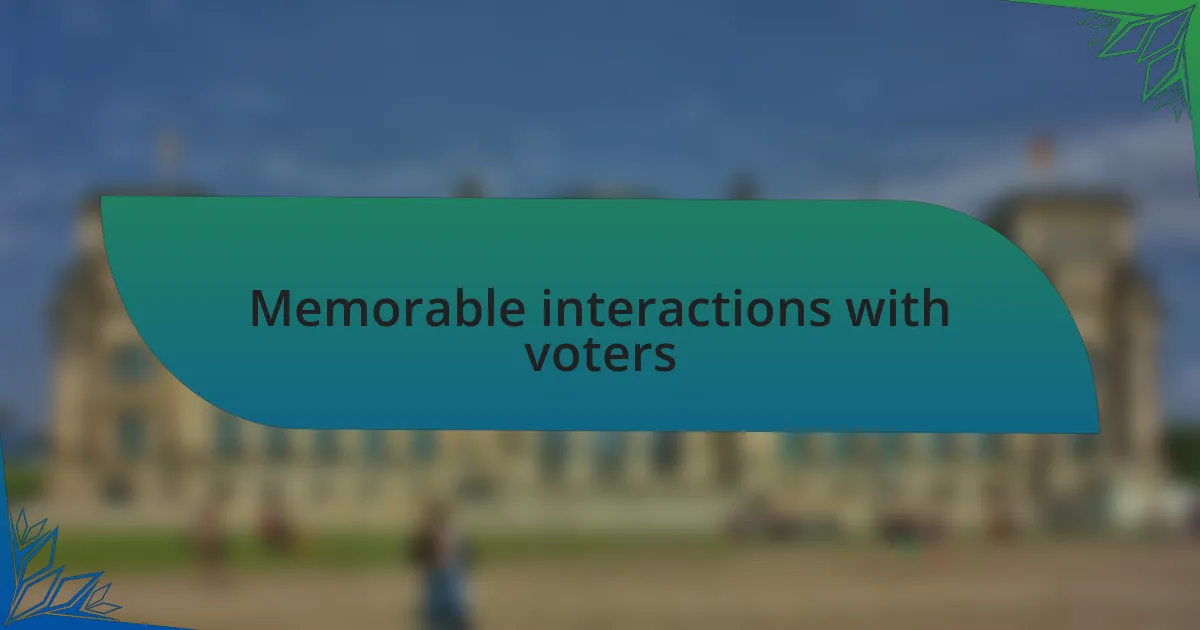
Memorable interactions with voters
One interaction that stands out in my mind happened on a chilly afternoon as I approached a family in their yard. The grandmother, sitting in her rocking chair, listened patiently while I discussed the campaign. When I finished, she simply smiled and said, “You’re the future, dear,” and handed me a freshly baked cookie. In that moment, I felt not just the weight of the campaign but also the warmth of human connection—a reminder that these interactions can transcend politics and highlight our shared humanity.
There was another occasion when I spoke with a young man who seemed skeptical about the political process altogether. Initially, he was guarded, crossing his arms as he leaned against a fence. But as we talked, I asked him about his concerns and listened without interruption. His demeanor shifted as he opened up about his frustrations with local leadership. I couldn’t help but feel a spark of hope; here was someone who simply needed to feel heard. How often do we overlook the power of simply listening in today’s fast-paced political climate?
Then, there was the time I met an elderly veteran who eagerly recounted stories from his service days. He shared his worries about how young people today perceive sacrifice and duty. That conversation was a striking juxtaposition to the indifference I encountered elsewhere. It reminded me that while campaigning, we often find inspiration in the most unlikely places. Isn’t it fascinating how every person carries a story that can reshape our understanding of the issues we advocate for?
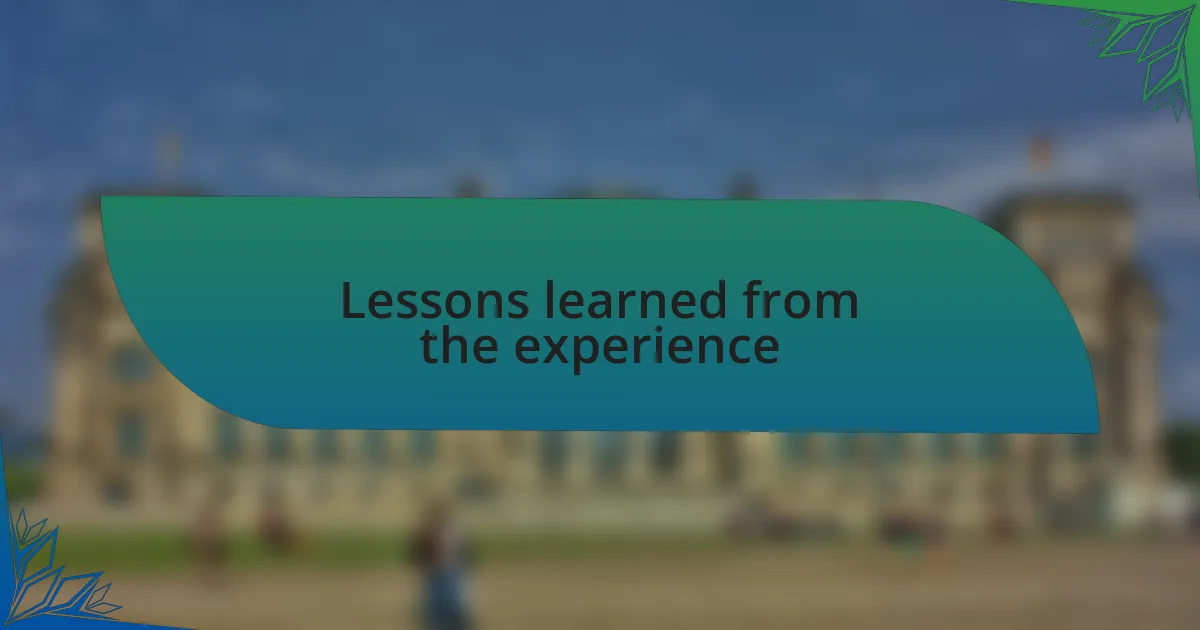
Lessons learned from the experience
While canvassing, I learned the importance of adaptability. I vividly recall a moment when I approached a small group of teenagers who were more interested in their phones than the conversation I tried to start. Instead of delivering my usual pitch, I pivoted and asked them questions about their interests and concerns. This shift not only grabbed their attention but also sparked a genuine dialogue that revealed their sentiments about the election. Isn’t it interesting how being adaptable can transform a cold reception into meaningful engagement?
Another lesson that resonated with me was the power of vulnerability in conversation. There was a time when I found myself sharing my own frustrations about the political system with a middle-aged woman who seemed disillusioned. Rather than simply presenting facts or statistics, I opened up about my own motivations for being involved in the campaign. That moment of honesty fostered a rapport that led her to share her own story of struggle and hope. It made me realize how vulnerability can become a bridge between differing perspectives and encourage deeper connections.
Lastly, I was struck by how critical it is to remain patient. I spoke to many individuals who had strong opinions but were hesitant to change their minds. I remember one gentleman who vehemently opposed my candidate. Instead of pushing back, I gave him the space to express his concerns fully. After a lengthy discussion, he still didn’t agree with me, but I could sense a subtle shift in his openness to consider other viewpoints. It was a gentle reminder that patience is often more impactful than persuasion, isn’t it?